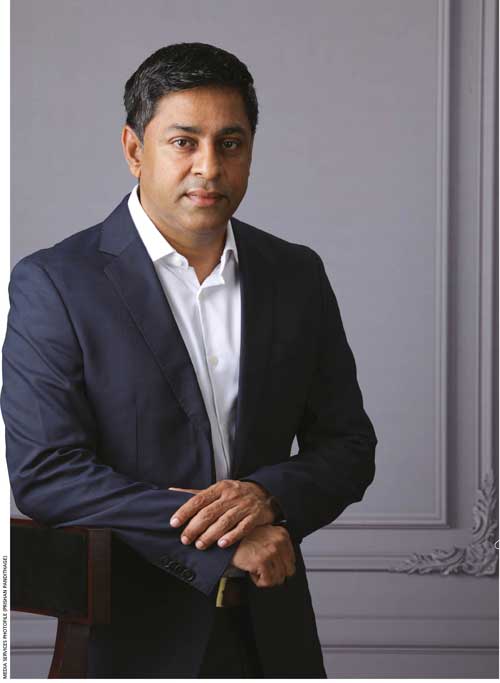
DIGITAL HUB
Compiled by Yamini Sequeira
NURTURING DIGITAL NATIVES
Naresha Supramaniam treads the path leading to our digital hub aspirations

In its latest investment guide, the Board of Investment of Sri Lanka (BOI) positions the country’s IT industry as “the fastest growing ICT hub in South Asia with currently US$ 1 billion in exports and projected to reach three billion dollars by 2025.”
Furthermore, the 2022 Compensation and Benefits Report for Sri Lanka’s IT-BPM (business process management) sector by the Sri Lanka Association for Software and Services Companies (SLASSCOM) notes that there’s been a 22 percent rise in Sri Lanka’s ICT workforce as a whole, implying a favourable trend in the local job market.
Meanwhile, the government unveiled DIGIECON 2030 to accelerate Sri Lanka’s progress towards an inclusive digital economy by leveraging advanced technology-based solutions.
DIGIECON 2030 encompasses a digital master plan and regulatory policy framework, along with a series of annual events that will provide direction for the facilitation of a digital ecosystem.
Over the past few years, Sri Lanka’s information technology industry has taken significant steps towards incubating talent through the introduction of IT-related curricula in both government and private institutions, the implementation of robust learning and development programmes in existing IT organisations, and outreach programmes by national bodies at the school level.
FINE-TUNING While these are salutary initiatives, they also need to be refined and fine-tuned frequently, to ensure that they stay relevant in terms of skill sets and new technologies.
Naresha Supramaniam says: “Arguably, less attention has been paid to demand origination. It’s imperative that new entrants to the IT workforce find gainful, lucrative employment – because otherwise, the entire industry will be stymied and become moribund.”
“To ensure that this does not transpire, we first need an identity for Sri Lanka’s IT services industry. If I want to hire talent from Eastern Europe, people will acknowledge that it’s a great idea as they’ve heard of great tech talent in the region,” he says.
Supramaniam adds: “This perception of the technical credentials of Eastern European talent is not based on empirical data; it’s a perspective that the region has been able to propagate. We need to do the same for Sri Lanka’s talent too!”
“To ensure the sustainability of the industry, there needs to be a concerted effort and much thought put into creating demand. There also needs to be a sustained focus on establishing mentorship programmes so that new talent is offered essential hands-on experience prior to being deployed on engagements,” he elaborates.
Supramaniam sees potential for global investment in Sri Lanka’s IT-BPO (business process outsourcing) sector: “I have always believed that the quality of talent in Sri Lanka is second to none. We have some of the most innovative minds in this country; and as a demographic, we’re also empathetic, open to new ideas and willing to relearn processes.”
PERCEPTIONS He believes that the only factor lacking is a platform to showcase our IT talent to the world at scale, noting that “there’s an opportunity for Sri Lanka to capitalise on the political unrest in Eastern Europe and the resource churn in India, and position itself as a viable alternative to both markets.”
Supramaniam reflects: “So what characteristics do we want associated with IT in Sri Lanka? A great product development mindset? The ideal location for offshore banking delivery centres? A truly ‘digital native’ thought process?”
“Everyone has heard about Sri Lanka being a great tourist destination. Now the world needs to be educated about the country being an IT services destination. We need road shows, round table discussions and C-suite visits arranged at the country level to promote the industry – and all this needs to be done now!” he emphasises.
When rating gender parity in the industry compared to that phenomenon in comparable markets, he explains that overall, “gender parity is better in Sri Lanka in the context of comparable markets,” and adds: “But we still have a lot of work to do to achieve acceptable ratios at leadership levels.”
The SLASSCOM report also discovered an improvement in women’s representation in the IT industry – with 35 percent female participation compared to the previous year’s 29 percent. Meanwhile, the BPM sector registered female participation at a healthy 46 percent.
He asserts: “Sri Lanka is well suited to service digital demand – be it cloud, data, data on cloud, AI and so on. All these skill sets will be incubated and fostered in the geography.”
POTENTIAL In terms of the main growth avenues presently available to the industry, Supramaniam notes: “In general, there is an explosion of digital opportunities in global markets as organisations rapidly modernise to take advantage of new and disruptive technologies, and online channels.”
“There is also a lot of excitement about the advent of generative AI, and its potential to disrupt repetitive, operational and manual work streams. This is something we really want to stay ahead of. We feel it can revolutionise the world we live in and the way in which we operate,” he declares.
Supramaniam believes that “there is ample opportunity to position Sri Lanka as a digital hub to take advantage of these new trends and technologies.”

Sri Lanka ranks high on Gartner’s and Kearney’s outsourcing rankings as it also acts as an offshore development centre for Fortune 500 companies in the US, Ireland, the UK, Australasia and Sweden, as well as joint ventures based in Sweden, Norway, the United States, Japan and so on.
Assessing the level of entrepreneurship and innovation in the IT and BPO sectors, he says: “We need better access to global investor networks and fairs to showcase true Sri Lankan ingenuity and secure funding. Our local entrepreneurs and innovators also need to think big, and tap into markets and opportunities beyond the confines of our borders.”
“Overall, I remain extremely optimistic about the future of this industry and its contribution to the growth of our country,” Supramaniam concludes.







